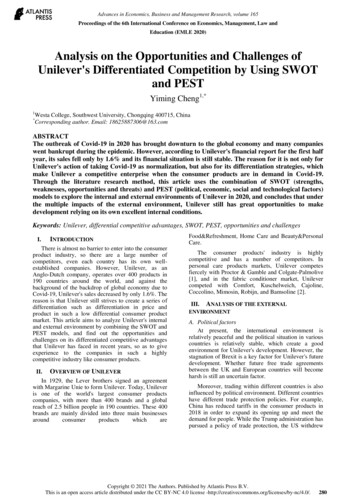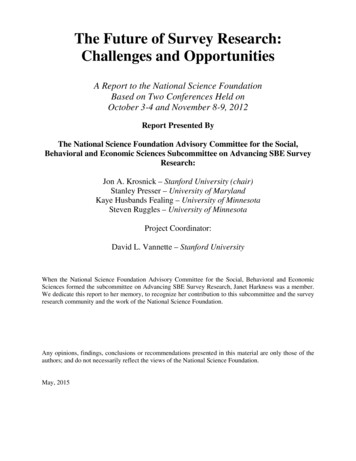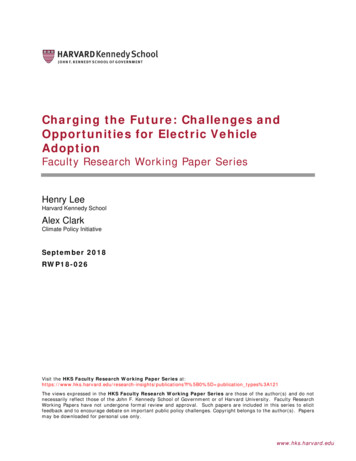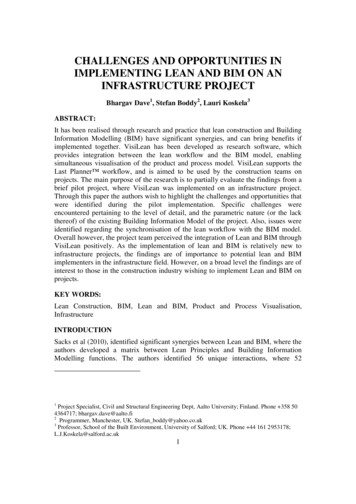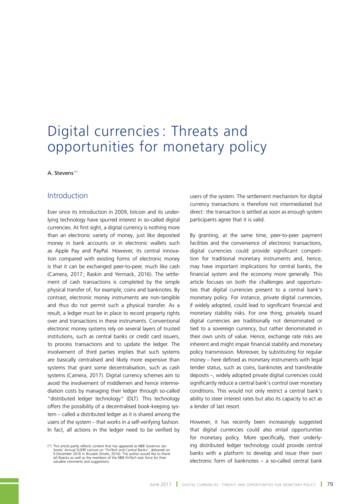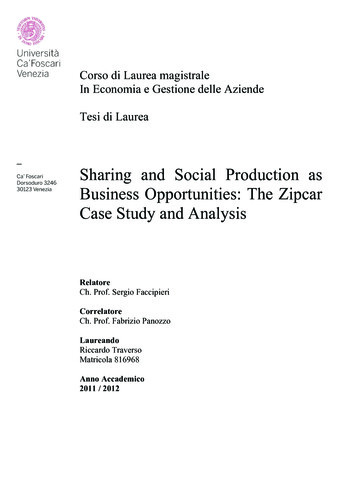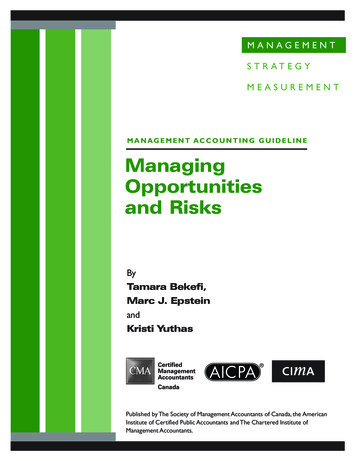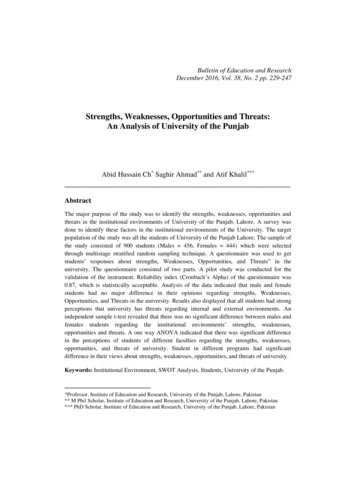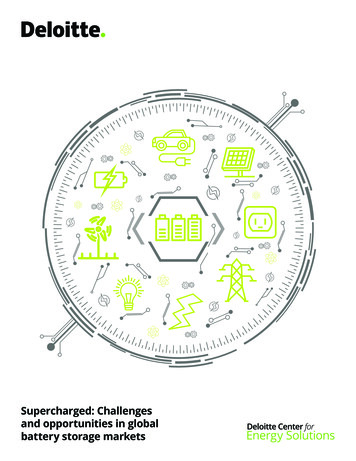
Transcription
Supercharged: Challengesand opportunities in globalbattery storage markets
Brochure / report title goes here Section title goes here ContentsExecutive summary1Introduction2Market drivers3Challenges9Focal points for storage providers14Advances in digital technologies spur new business models15Conclusion18Endnotes1903
Supercharged: Challenges and opportunities in global battery storage marketsSupercharged: Challenges and opportunitiesin global battery storage marketsUnited KingdomGermanyJapanItalyUnited StatesSouth KoreaIndiaChileAustraliaExecutive summaryThis report examines how some of the nations thatare more actively modernizing their electric powergrids and adding renewable energy are approachingenergy storage. Particularly focusing on batterystorage in electric power grids, we sought to uncoverwhat is driving the push for energy storage andwhat utilities, policymakers, and other stakeholdersare doing to develop storage markets and supportongoing deployment. Our findings revealed a broadrange of market drivers and remaining barriers, butthey also revealed a commonality: the pace of productdeployment and market development is accelerating.Battery storage is flexible, can be deployed quickly, hasmultiple applications, and can produce numerous valuestreams—not to mention that battery prices are fallingfaster than anticipated. However, the dynamism in thesector is not solely attributable to these factors.Advances in adjacent digital technologies, such asartificial intelligence, blockchain, and predictive analytics,are giving rise to aggregated solutions and innovativebusiness models that were nearly inconceivable afew years ago. Start-ups around the world are rapidlycommercializing intelligent networks of “behind-themeter” batteries to benefit electricity customers,utilities, and grid operators.Our analysis provides a global view of how muchprogress has been made in the area of aggregation aswell as in other forms of battery solution developmentand deployment. It also provides utilities, independentpower producers (including renewable energycompanies) and other stakeholders in the energy valuechain with insight into global trends in battery storage,particularly what is working well, what is not, and whatchallenges still remain.1
Supercharged: Challenges and opportunities in global battery storage marketsIntroductionDepending on which analysis one reads, the globalmarket for energy storage is poised to grow rapidly,but few can agree on how much. According to onewidely publicized projection, the storage market couldreach more than 26 billion in annual sales by 2022, acompound annual growth rate (CAGR) of 46.5 percent.1Another analysis envisages growth at a more modest,but still robust, pace, expanding at a compound annualgrowth rate of 16 percent and reaching 7 billionannually by 2025.2 Others put it somewhere in themiddle, while a few take a slightly more optimistic orpessimistic view.These countries include Australia, Chile, Germany, Japan,India, Italy, South Korea, the UK, and the US. Particularlyfocusing on battery storage, which is presently theleading technology, our examination sought to uncoverwhat has been driving the push for energy storage inthese nations and what utilities and policymakers havebeen doing to define battery storage, develop storagemarkets and to support ongoing deployment.In presenting our findings, we begin by exploring keymarket drivers for battery storage.The divergence of opinions largely originates withhow one defines energy storage. Some analysescalculate only “front-of-the-meter” utility-scaletechnologies, while others include “behind-themeter” solutions implemented by commercial andindustrial (C&I) customers. And others include electricvehicle batteries and smaller scale battery-plus-solarcombinations implemented by residential consumers,which could have not only behind-the-meterapplications but also front-of-the meter uses if theyare controlled by aggregators or utilities. Complicatingthe picture even more are the many applications forenergy storage, which can be useful in integratingrenewables, supporting smart grids, creating moredynamic electricity markets, providing ancillaryservices, and bolstering both system resiliency andenergy self-sufficiency.Despite the complexity of the landscape, many growthprojections agree that energy storage is gainingtraction around the world and could fundamentallychange market dynamics. To understand theseshifting dynamics, we peered beneath the aggregategrowth projections to examine how some of the moreactive nations in renewable development and gridmodernization are now approaching energy storage.2Photo courtesy of Tesla, Inc.
Supercharged: Challenges and opportunities in global battery storage marketsMarket driversDriver 1: Cost and performance improvementsEnergy storage in various forms has been aroundfor decades. This begs the question: why batterystorage and why now? Perhaps the most obviousanswer is declining costs and improved performance,particularly relating to lithium-ion batteries, sinceexpanding electric vehicle markets are promotingmanufacturing economies of scale. As illustrated inFigure 1, costs for lithium ion batteries are decliningat a steep trajectory. However, in examining the ninenations in our analysis, it became apparent thatdeclining costs are only part of the story.Figure 1. Lithium-Ion battery prices fell 80% from 2010-2017 ( /kWh) 1,200 1,000 1,000 800 800 642 600 599 540 400 350 273 200 02010201120122013201420152016 2092017Source: Bloomberg New Energy Finance, Lithium-ion Battery Price SurveyNote: The survey provides an annual industry average battery (cells plus pack) price for electric vehicles and stationary storage.Stationary storage developers paid about 300/kWh for battery packs in 2017— 51% more than the average automaker priceof about 199. This is typically due to much lower order volumes.3
Supercharged: Challenges and opportunities in global battery storage marketsDriver 2: Grid modernizationDriver 3: Global movement toward renewablesMany developed countries are embarking on gridmodernization programs to boost resilience in the faceof severe weather events, reduce system outages linkedto aging infrastructure, and improve the overall efficiencyof the system. These programs often involve deployingsmart technologies within established electrical grids toenable two-way communication and advanced digitalcontrol systems, along with integrating distributed energyresources (i.e., renewables, fuel cells, diesel or natural gasgenerators, storage assets, and microgrids).Broad support for renewables and emissions reductionis also driving adoption of battery storage solutions.The critical role that batteries can play in offsetting theintermittency of renewables and reducing curtailmentis well known, but the strength and pervasivenessof the desire for clean energy among all types ofelectricity customers is growing. This is especiallyapparent within the corporate and public sectors.As noted in the recent Deloitte report, Serious Business:Corporate procurement rivals policy in driving the growthof renewable energy, large multinational corporationshave taken a leadership role in procuring renewableenergy around the globe. Indeed, many have publiclypledged to reach 100 percent renewable energy in thenext two decades or sooner through programs such asRE100 and the Renewable Energy Buyers’ Alliance.7 Thisbodes well for continued renewable development and,presumably, for continued deployment of batteriesto assist in integrating greater amounts of distributedenergy resources.In general, we found the growth of battery storagegoes hand-in hand with grid modernization efforts,including the transition to smart grids. Digitizing thegrid enables prosumer participation,3 intelligent systemconfiguration, predictive maintenance, and self-healing,and it paves the way for the implementation of tieredrate structures—all of which create opportunities forbatteries to generate value by adding capacity, shiftingload, and/or improving power quality. While smarttechnologies have been around for some time, batterieshelp to unlock their full potential, and vice versa.Tesla, in conjunction with Neoen, recentlycompleted the world’s largest lithium-ionbattery installation (100 MW) in SouthAustralia.4 After an outage in 2016 that caused1.7 million residents to lose power, the state ofSouth Australia commissioned the battery aspart of a larger grid-modernization effort tohelp address supply shortfalls, soaring prices,and concerns over system reliability andresilience.5 The giant battery installationstores excess energy from the nearbyHornsdale wind farm during off-peak timesand discharges it back into the grid to correctsupply and demand imbalances and toprovide fast-response emergency powerduring outages.64A new technology for integrating batterysystems into solar plants has the potential toboost their energy output. Florida Power &Light Company is piloting the innovativeDC-coupled battery system at its Citrus SolarEnergy Center.8 By capturing energy thatexceeds inverter capacity when the sun’s raysare strongest, the battery system has thepotential to harness millions of kilowatt-hoursof surplus solar energy a year that wouldnormally be lost, thus improving both thequantity and predictability of the plant’soutput.9 Increased predictability, in turn,enables the utility to more efficiently dispatchother power plants, helping customers to saveon energy costs.10
Supercharged: Challenges and opportunities in global battery storage marketsDriver 4: Participation in wholesaleelectricity marketsThough renewables and batteries are often mentionedin the same sentence, battery storage can help balancethe grid and improve power quality regardless of thegeneration source. This points to a growing globalopportunity for batteries to participate in wholesaleelectricity markets. Within our analysis, nearly everynation is revamping its wholesale market structure toallow batteries to provide capacity and ancillary services,such as frequency regulation and voltage control. Theseapplications are still nascent and are finding variedsuccess as policymakers work to remove barriers tostorage participation and markets recalibrate.Take Germany’s primary control reserve (PCR) marketfor example. Participants in this market generaterevenue by winning a weekly auction and receivingremuneration for providing capacity to balance thegrid.11 While the PCR market has been open tostorage providers for the past few years, batterydeployment did not become significant until2016, when declining system costs allowed for aviable return on investment.12 Unlike conventionalgenerators, batteries are able to respond to systemimbalances almost instantaneously, becoming fullyactivated in less than the required 30 seconds.13However, because there is no remuneration for fastresponse in Germany as there is in the US, batteryproviders compete directly against establishedincumbents such as gas peaker plants. On one hand,this undifferentiated competition has been effectivein driving down the cost of capacity, but on the other,it has led to rapid market saturation, thin margins,and an uncertain economic situation for batterystorage providers. With little room to grow in the PCRmarket, battery solution providers in Germany areincreasingly setting their sights on the secondaryreserve market and distribution deferral aspotential new value streams.14As in Germany, some grid operators in the US have alsoallowed batteries to compete in their systems.15 Theopening of US wholesale electricity markets to providersof fast-responding resources such as batteries andflywheels can largely be attributed to Federal EnergyRegulation Commission (FERC) Orders 755 and 784,issued in 2011 and 2013, respectively.16 These Ordersspecified that speed and accuracy must be rewardedin ancillary services markets.17 Since inviting batteryproviders to participate in frequency regulation markets,grid operators have been challenged by some initialimbalances in the mix between fast-ramping and slowerramping resources and matters related to dispatchparameters, signals, and other technical requirements.However, moving ahead, our findings suggest thatthe benefits of integrating batteries into wholesaleelectricity markets can outweigh these growing pains,since policymakers around the world are increasinglytaking action to reward the contributions fast-actingbatteries can make to balance grid operations. Forinstance, Chile’s national energy commission hasdrafted a new regulatory framework for ancillaryservices that recognizes the contributions that batterystorage systems can provide.18 Italy too has openedits ancillary services market to pilot renewable energyand storage projects as part of sweeping regulatoryreform efforts.19 And, on February 15, 2018, FERC issueda final rule on taking further steps to remove barriersto the participation of electric storage resources in thecapacity, energy, and ancillary services markets subjectto its jurisdiction.20The President of Chile, Michelle Bachelet, has introduced anew long-term national energy strategy that sets a goal ofgenerating at least 70 percent of the nation’s electricityfrom renewable sources by 2050.21 In support of integratingmore renewables into the country’s electrical grid, thenational energy commission in Chile has drafted newancillary services regulations that would make energystorage part of its regulated system and pave the way forbattery technologies to offer rapid frequency responseservices.22 The regulatory updates have caught theattention of battery manufacturers, some of whom are noweyeing the market not only to take advantage of theancillary services opportunity but also to provideinfrastructure for mitigating transmission bottlenecks andfor storing the output from the country’s abundant solarand wind plants. For instance, NEC has already deployedseveral project
Supercharged: Challenges and opportunities in global battery storage markets 2 Introduction Depending on which analysis one reads, the global market for energy storage is poised to grow rapidly,

